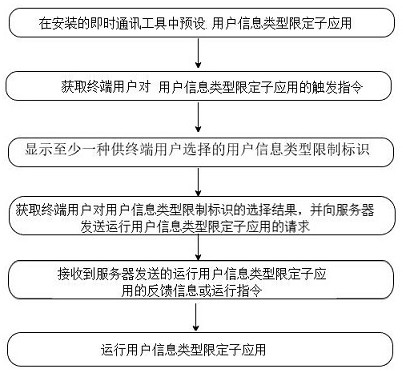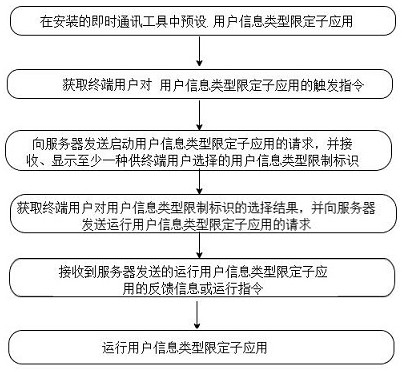Application method, client, terminal, device, server and storage medium for limiting user types in instant messaging
A technology of user type and application method, which is applied in the branch office to provide special service devices, digital transmission systems, data exchange networks, etc., can solve problems such as inability to guarantee instant communication and unsatisfaction, and achieve the effect of improving communication efficiency
- Summary
- Abstract
- Description
- Claims
- Application Information
AI Technical Summary
Problems solved by technology
Method used
Image
Examples
Embodiment approach 1
[0044] This embodiment provides an application method for user type limitation in instant messaging, including the following steps, the flow chart is as follows: figure 1 :
[0045] S1: Preset user information types in the installed instant messaging application to limit sub-applications;
[0046] Among them, the user information type limited sub-application is an application that depends on the operation of the instant messaging application program; the user information type limited sub-application limits the participating end users to display, view, query or be queried in the user information type sub-application after running The user information type and / or the user information data associated with the user information type; in the instant messaging application, the same terminal user has at least two of the user information types, and each user information type defines that the sub-application is associated with different user information after running Each user informat...
Embodiment approach 2
[0057] This embodiment is roughly the same as Embodiment 1, except that in S3, a request to start the user information type restriction sub-application is sent to the server, and at least one user information type restriction identifier for the terminal user to select is received and displayed. Such as image 3 shown.
[0058] For example, in the example of Embodiment 1, after the user triggers the "create blog" control in the terminal interface, the client first sends a request to the server, and the server sends the client two optional user information types of business friends and friends After restricting the sub-applications, the server sends the available user information types to the client according to the preset judgment to limit the sub-applications, and the client only pops up the two controls of "Business Friends" and "Friends" on the terminal interface.
[0059] Apart from this, this embodiment is completely the same as Embodiment 1, and details are not repeated ...
Embodiment approach 3
[0061] This embodiment is a further improvement of Embodiment 2, the main improvements are as follows: Figure 4 As shown, in Embodiment 2, after obtaining the selection result of the user information type restriction identifier by the end user, it is also judged whether the request to run the user information type restriction sub-application to the server meets the preset condition, and if so, send the request to the server. The server sends a request to run a sub-application limited by the type of user information.
[0062] The above preset conditions are:
[0063] Whether the number of contact IDs selected by the end user meets the requirements for starting and running the number of user information type limited sub-applications; the contact ID means the contact's nickname, name or avatar and other information.
[0064] A specific example is listed below to illustrate this embodiment more clearly:
[0065] In a software for creating group chats in the mobile phone, the su...
PUM
 Login to View More
Login to View More Abstract
Description
Claims
Application Information
 Login to View More
Login to View More - R&D
- Intellectual Property
- Life Sciences
- Materials
- Tech Scout
- Unparalleled Data Quality
- Higher Quality Content
- 60% Fewer Hallucinations
Browse by: Latest US Patents, China's latest patents, Technical Efficacy Thesaurus, Application Domain, Technology Topic, Popular Technical Reports.
© 2025 PatSnap. All rights reserved.Legal|Privacy policy|Modern Slavery Act Transparency Statement|Sitemap|About US| Contact US: help@patsnap.com



